
At Poynter & Bucheri Accident Recovery, our proactive and recovery-focused approach helps alleviate the stress of a pedestrian accident. Your attorney will work with you to understand your concerns, discuss your expectations, and explain your options.
You can trust your accident lawyer to provide an honest assessment of your case and help determine your potential routes to pedestrian accident compensation. Count on us to be by your side during your pedestrian accident claim and help you efficiently navigate the legal process while seeking the best possible outcome for your emotional, mental, and financial health.
Choose Poynter & Bucheri Accident Recovery for Your Pedestrian Accident
We understand the array of concerns individuals face after accidents, and that’s why our accident attorneys operate with a client-friendly fee structure for pedestrian accident claims. We believe in providing you with a transparent and affordable arrangement for legal counsel.
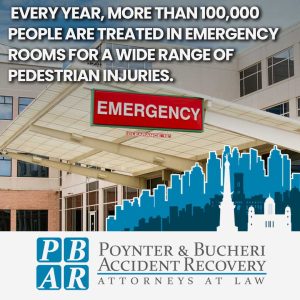
Our pedestrian accident lawyers work on a contingency fee basis, ensuring that you only pay if we secure a favorable settlement on your behalf. Our fee is 25% of the settlement amount, significantly lower than comparable firms.
Open communication and transparency are core values at our law firm and our goal is to empower our clients with the knowledge to make informed decisions about legal representation for any injury claim. We aim to alleviate the financial burdens while allowing you to focus on your recovery.
If you were injured in a pedestrian vs. motor vehicle accident, an experienced pedestrian accident lawyer can help you get the compensation you deserve. Contact us today for a free consultation at (800) 265-9881.
Pedestrians at Risk in Indianapolis
According to the National Highway Traffic Safety Administration (NHTSA), more than 60,000 pedestrians are injured in U.S. motor vehicle accidents every year. Here in Indiana, road fatalities have been rising steadily after hitting a historic low in the previous decade.
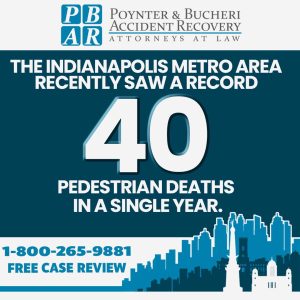
Indianapolis sits at the epicenter of Hoosier traffic dangers. The Indianapolis metro area recently saw a record 40 pedestrian deaths in a single year. The city has densely populated urban areas, construction zones, shopping districts, multi-directional traffic flows, and other risk factors for pedestrian accidents.
Whenever a pedestrian is near a motor vehicle, there’s always a risk of an accident. Anyone who spends time outside of their home is considered a pedestrian at multiple points during the day.
Whether you walk to work daily or simply cross the street to check your mailbox, you could be a pedestrian injured in an accident. Anytime you pass through a roadway, driveway, parking lot, or near vehicles, you’re at risk of being hit by a car, truck, or another type of vehicle.
Types of Compensation for Indiana Pedestrian Accidents
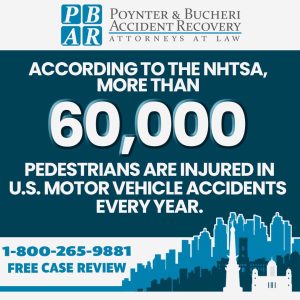
Compensation can be awarded for a variety of costly damages incurred. Even minor accidents without serious injuries can result in expensive medical costs, pain and suffering, and forced time off work for recovery.
More serious accidents can bring catastrophic injuries with lengthy hospital stays, surgeries, and medical expenses, not to mention the loss of income from the accident.
Accident attorneys help people recover compensation for the following types of damages in car accidents and pedestrian crashes:
- Medical expenses including emergency treatment, hospital stays, surgeries, physical therapy, prescription medications, counseling, and more
- Loss of income, including future lost wages and loss of earning capacity
- Emotional pain and suffering, PTSD, depression, anxiety, and mental anguish
- Physical pain and suffering
- Permanent disability or disfigurement
- Loss of enjoyment of life, loss of consortium, and more
- In the case of a fatality and wrongful death, funeral and burial expenses
- Any additional out-of-pocket expenses brought about by the accident
Accident lawyers provide valuable insight into potential personal injury claim values. Although you may work with a personal injury lawyer, you may not need to pursue a personal injury lawsuit for your pedestrian injury. Many of these cases are resolved through settlements and car insurance claims.
Determining Fault and Proving Negligence
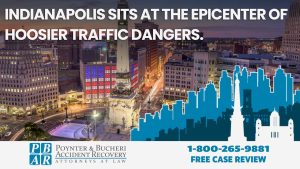
Determining fault is an important step in sorting out the accident. If you can prove fault, you’re on the way to a successful outcome. Accident lawyers help injured people understand pedestrian laws and who may be at fault. It takes an attorney familiar with your case to understand the details.
Accident fault is determined by establishing negligence, which is when a negligent driver fails to exercise a reasonable level of care when going about their activity based on the circumstances. Negligence may be proven in an accident involving someone who fails to obey traffic laws and acts irresponsibly when operating a vehicle.
Injured pedestrians should rely on accident lawyers for legal insight, not car insurance companies, friends, or family members. Your personal injury lawyer is on your side and qualified to provide legal representation, unlike an insurance representative or loved one.
Pedestrians and Indiana At-Fault Laws
Indiana uses the comparative negligence rule, which means fault will be compared and assigned to each person as a percentage of blame. The injured party can seek compensation from the at-fault driver’s insurance for their damages with the help of a personal injury lawyer.
More than one party may be found at fault under comparative negligence, so don’t worry if you have partial liability for a pedestrian or car accident. In Indiana, if you are an injured person found to be less than 50% at fault, you still can pursue compensation equal to your percentage of liability.
Accident lawyers can tell you that not all pedestrian accidents are alike, and it’s not always a pedestrian vs. car accident. A personal injury attorney or pedestrian accident attorney could help you with an accident on someone’s property. Visit our pages about slip-and-fall injuries, dog-bite injuries, car accident cases, or personal injury cases. Call us today at (800) 265-9881.
Common Pedestrian Injuries in Indianapolis
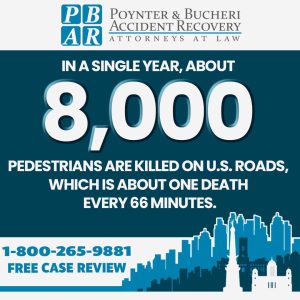
Accidents cause life-altering injuries. Every year, more than 100,000 people are treated in emergency rooms for a wide range of pedestrian injuries, according to the CDC.
In a single year, about 8,000 pedestrians are killed on U.S. roads, which is about one death every 66 minutes. Age groups including older citizens and children have the highest risk for severe injuries from motor vehicles.
Common Pedestrian Accident Injuries Include:
Traumatic Brain Injuries (TBIs)
A traumatic brain injury can result in permanent damage as well as symptoms such as dizziness, headaches, confusion, memory loss, loss of consciousness, difficulty speaking, difficulty sleeping, blurred vision, tinnitus, and much more.
Spinal Cord Injuries
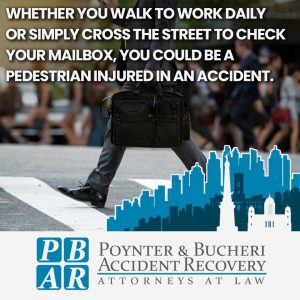
Injuries to the spinal cord can result in permanent damage such as loss of bladder function or control, loss of sexual function, difficulty or inability to walk, loss of sensation, altered reflexes, paralysis, and even death.
Fractures
Common broken bones from pedestrian accidents include arm, wrist, hip, back, shoulder, leg, and ankle fractures.
Internal Injuries
Common injuries internally include those that cause abdominal pain, bloody urine, nausea, vomiting, and loss of consciousness.
Lacerations
Lacerations are cuts or wounds to the skin that easily can become infected if not properly treated. Oftentimes lacerations will require stitches.
Contusions
Contusions, or bruises, can occur with blunt force trauma. They can occur on bone, muscle, and skin tissue and be quite painful as well as unsightly.
Common Causes of Pedestrian Accidents
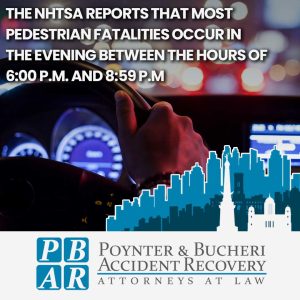
Why do pedestrian accidents happen? The NHTSA reports that most pedestrian fatalities occur in the evening between the hours of 6:00 p.m. and 8:59 p.m. Distracted driving by negligent drivers is a common cause. The risk of serious injury is also higher when and where people are consuming drugs and alcohol.
Here are some of the most common causes of accidents involving pedestrians.
Causes Related to Pedestrians
- Crossing at a non-intersection (jaywalking).
- Walking in low-visibility weather.
- Early morning and late evening walking.
- Crossing as a walk sign is expiring.
- Failing to look in both directions before crossing.
- Texting while walking.
- Stopping suddenly in a crosswalk.
- Using the roadway rather than the sidewalk, shoulder, or path.
- Listening to music or having earbuds in while walking.
- Crossing behind parked cars.
Causes Due to Drivers
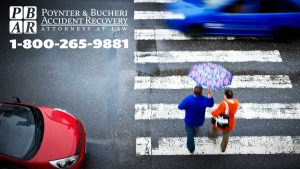
- Driving under the influence of alcohol or drugs.
- Exceeding the speed limit.
- Distracted drivers.
- Not using the turn signal, particularly at intersections.
- Failing to make a full stop at intersections.
- Not checking rearview mirrors before backing up.
- Rushing through an intersection as the light changes.
- Running traffic signals.
- Failing to stop at stop signs.
- Making illegal U-turns.
- Driving too close to the shoulder.
- Attempting illegal passes.
Causes Due to Cyclists
- Salmoning, or driving against the flow of traffic.
- Failing to yield the right of way or follow traffic rules.
- Cycling during times of low visibility without proper reflective gear.
What to Do After a Pedestrian Accident
Were you hit by a car? A pedestrian accident is chaotic and unexpected, but your next moves may impact your ability to work with an accident lawyer to claim the compensation you deserve for your injuries. Personal injury cases often hinge on whether you follow these steps to protect your health and legal options.
1. Get to a safe place.
If you are on the road, get off of the roadway to prevent additional accidents. If you are unable to move, direct someone to call 911 for immediate medical attention. Do not leave the scene.
2. Seek medical attention right away.
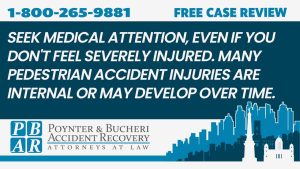
Seek medical attention, even if you don’t feel severely injured. Many pedestrian accident injuries are internal or may develop over time. Let your doctor know that you were involved in an accident. Request medical records to show proof of your accident and the reason for your visit.
3. Follow your doctor’s orders.
Keep up with the routine of care the doctor prescribes. Track your symptoms and treatments in a journal.
4. Report the accident.
Call the police and file an official report of what happened, even if you did not call 911 at the time. Avoid making statements that assign blame. Do not apologize or claim responsibility. Request a copy of the police report.
5. Exchange and gather information.
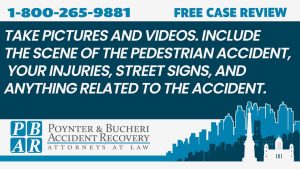
Exchange information with the other parties involved in the accident. Get insurance and contact information. Gather witness information, which can come in handy during a trial or insurance claim.
Take pictures and videos. Include the scene of the pedestrian accident, your injuries, street signs, and anything related to the accident. Save physical evidence, including your clothes and footwear. Your pedestrian accident lawyer can use them to show your shoes or clothing in no way contributed to your accident.
6. Stay off social media.
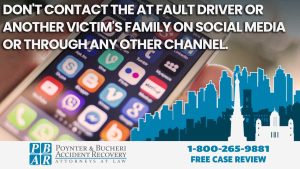
Resist the temptation to turn to social media. Insurance companies are eager to find reasons to deny claims and are known to scroll social media to find any evidence of negligence or a lack of credibility.
Also, don’t contact the at fault driver or another victim’s family on social media or through any other channel. Pedestrian accident lawyers and personal injury attorneys usually say it’s best to avoid social media entirely until your accident claim has been settled.
7. Contact a pedestrian accident attorney.
In the days following the crash, the authorities will record their version of events in the official police record. The insurance company will decide who is at fault and determine what kinds of vehicle repairs may be needed.
Soon, you’ll probably receive a call from an insurance company wanting to wrap things up with your pedestrian accident case. Be careful before signing or agreeing to anything with an insurance company. This is where accident lawyers get involved.
You need a pedestrian accident attorney from a qualified legal team. Direct all inquiries to the experienced accident lawyer and let them use their expertise in pedestrian accident cases to protect you.
Personal injury attorneys provide valuable experience and wisdom. You may have a strong case for a pedestrian accident lawsuit, personal injury case, insurance company claim, or another route to claim compensation you need to recover.
How to Avoid Pedestrian Crashes
Here are an accident attorney’s tips for reducing the possibility of a pedestrian accident or car accident.
Tips For Pedestrians
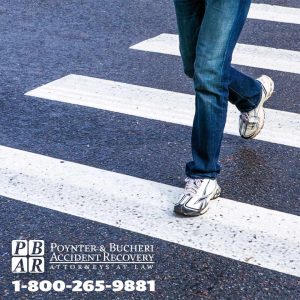
- When possible, walk with someone else to increase your visibility and wear bright or reflective clothing.
- Wear proper footwear to avoid losing your footing.
- Walk against traffic so that you can see it coming.
- Walk along the shoulder or on a path rather than the road itself.
- Avoid listening to music or talking on the phone while walking.
- Avoid crossing the street except at an intersection.
- Never try to dart across traffic.
- Avoid drinking or using drugs while walking, which can cause impaired decision-making.
- Always look both ways before crossing the street or behind a parked vehicle.
- Don’t allow children to walk unattended or play near roadways.
Tips For Drivers
- Never drink and drive or drive while under the influence of drugs.
- Do not exceed the speed limit.
- Be mindful of school zones and neighborhood speed limits.
- Watch for darting pets and children.
- When driving in the early morning or late evening, be on the lookout for pedestrians.
- Don’t text, talk on the phone, or use devices while driving.
- If you cause a car accident, remain at the scene with any injured pedestrian.
Tips For Cyclists
- Always ride your bike with traffic rather than against it, even on one-way streets.
- Be aware of your surroundings, especially in times of low light or low visibility.
- Look both ways before crossing traffic.
- Yield to the right of way.
- Be aware of pedestrian-only pathways.
Pedestrian Accident Attorney: No Attorney Fees Unless You Win

If you were hurt in a pedestrian accident, an Indiana pedestrian accident attorney may be able to help you take action to recover financial compensation. You deserve the best pedestrian accident lawyer and your first step is to contact Poynter & Bucheri, LLC for your free consultation with an experienced attorney.
We can help you pursue substantial compensation for your medical bills, lost wages, pain and suffering, and more. Call (800) 265-9881 to schedule your free case review with a pedestrian accident attorney and learn about your legal rights and options.
